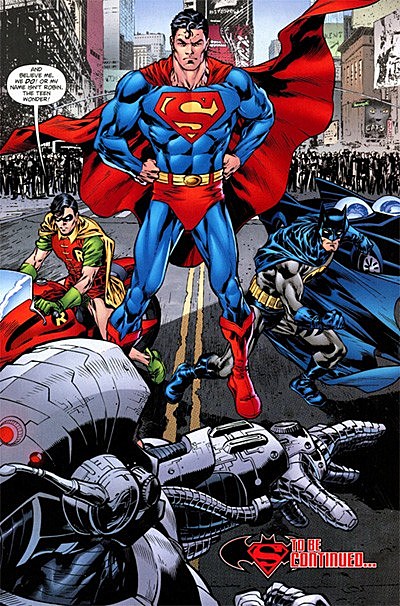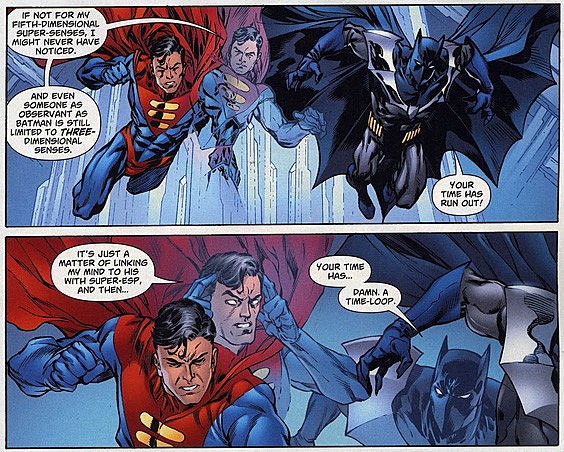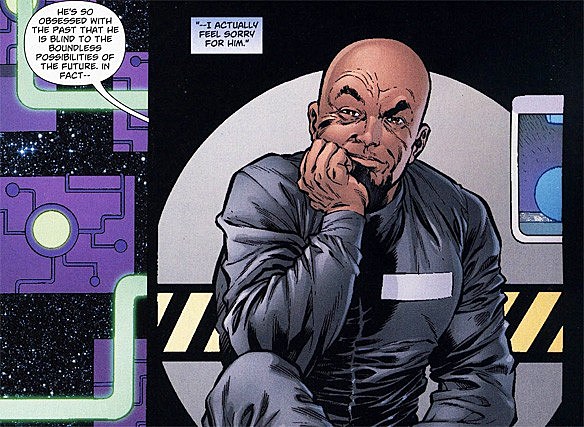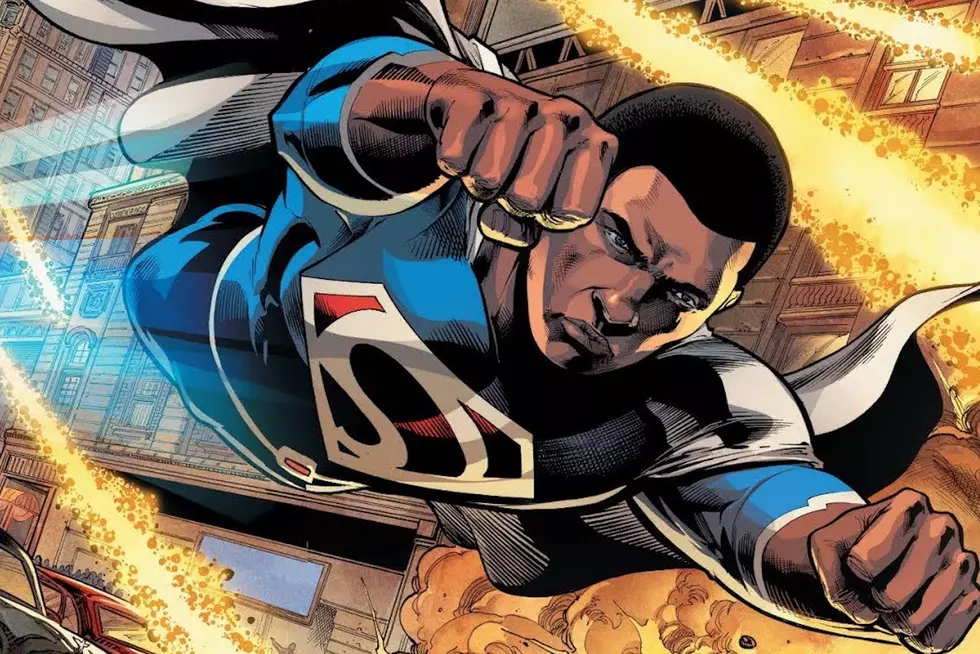
Superman/Batman #79 and 80: Looking to the Future with Chris Roberson
Last week, when I reviewed Superman #707, I said that I wished I could see what writer Chris Roberson would do with Superman if he wasn't saddled with having to clean up the mess of "Grounded." That was on Monday.

By Wednesday, my question had been answered in the pages of Superman/Batman #80, which finished a time-spanning two-part story by Roberson and artist Jesus Merino that featured the Supermen and Batman of two different eras (and more) fighting against Epoch, the Lord of Time. And the answer was that Roberson would do something amazing. In a lot of ways, it's easy to say that Roberson's story was a love letter to Grant Morrison's work at DC Comics, which comes through most obviously in the characters that he uses. The story's main selling point, after all, was that it featured the long-awaited (by me, anyway) return of the Superman and Batman of the 853rd Century, who first appeared in DC One Million. For those of you who haven't read the story, in which the present-day Justice League of 1998 is visited by their far-future counterparts from 1,000,000 months after the publication of Action Comics #1, I can assure you: It's the greatest crossover in DC History.
In a lot of ways, it's easy to say that Roberson's story was a love letter to Grant Morrison's work at DC Comics, which comes through most obviously in the characters that he uses. The story's main selling point, after all, was that it featured the long-awaited (by me, anyway) return of the Superman and Batman of the 853rd Century, who first appeared in DC One Million. For those of you who haven't read the story, in which the present-day Justice League of 1998 is visited by their far-future counterparts from 1,000,000 months after the publication of Action Comics #1, I can assure you: It's the greatest crossover in DC History.
Admittedly, that might not sound like much when you consider that its competition is stuff like Bloodlines and Armageddon 2001, but it was fantastic. It's one of the few crossovers that's able to claim that it's both epic in scale -- every DC title that month was numbered #1,000,000 and featured a story of the characters far-future counterparts, including Legion of Super-Heroes stories set a thousand years after the others -- and actually well-done. It's one of Morrison's greatest and most underrated works, and as is the case with a lot of things that fall into that category, it's been largely untouched since then.
It doesn't stop with the main characters either. There are cameo appearances from the futuristic version of Damian Wayne (as seen in Batman #666) and the Unknown Superman of 4500 AD (from All Star Superman), and background references to Prometheus and the Guardian, whom Morrison worked on in JLA and Seven Soldiers, respectively. Even the plot itself is highly reminiscent of Morrison's JLA/WildC.A.T.s, in which the two teams duked it out with Epoch.
But it goes beyond that. In fact, while there are references to other long-forgotten elements of DC ephemera like Elliot S! Maggin's Miracle Monday and an obscure far-future version of Batman who made his first appearance in 1955, it goes even beyond just being a showcase of stuff Roberson likes. Admittedly, I'm sure that he went all out to include as much of that stuff as he could, but here, they're puzzle pieces that come together to make a finished product that's way more than just a fun story.
What with the fact that it's the story of two different sets of Superman, Batman and Robin battling the same foe across time, the story owes a lot to the old Earth-1/Earth-2 team-up stories of the '70s, but with the key difference being that it's a team-up not between the past and the present, but between the past and the future. It's a simple change, and one that's been done before -- when the JLA/JSA format got stale, creators roped in the Legion of Super-Heroes and even the New Gods to spice things up -- but it also ties in directly with the underlying theme of where Roberson's going with this.
The first issue is very much your standard adventure story. Epoch gets apprehended after a scuffle with the 853rd Century's Justice Legion A, but then reveals that it was all a part of his plan to get to Batman's trophy room on Pluto (which apparently regains its planetary status sometime over the next 83,000 years) so that he can trade in his Silver Age duds for the futuristic "polyalloy armor" that he sported in JLA/WildC.A.T.s:

Once he's got his fancy new clothes, he traps Superman and Batman in a time loop and then heads out to do what Epoch always does: Attempt to conquer the present, wherein "the present" is somewhere between 1962 and 2011. He fails, of course; he always does, and in this story, it's even more of a foregone conclusion than it usually is because on the surface, the point of this story is that no matter where Epoch goes, there will always be a Superman and Batman there to stop him.
It's a pretty nifty concept for a story, but again, that's just on the surface. Once Epoch goes back in time, he runs into a Superman and Batman who are there to stand in his way, it's not the Superman and Batman that are running (or in Superman's case, walking) around in their monthly titles right now. Instead, it's another set:

It's clearly the Superman, Batman and Robin of the '70s. Batman's in his "classic" suit, Robin refers to himself as "the Teen Wonder," and there are other hints in dropped into #80, like Jimmy Olsen being a reporter for WGBS rather than the Daily Planet. This is a very specific choice on Roberson's part, and while he's often talked about his fondness for that era of DC stories in interviews, I think it once again goes beyond the obvious.
This set of heroes represents a very definite era in the history of DC comics. Stop me if you've heard this one, but these are heroes from an era where Barry Allen was the Flash, Hal Jordan was Green Lantern and Ray Palmer was the Atom. I've talked quite a bit here at ComicsAlliance about the perils of nostalgia, and here it is, writ large on the page as the one area in all of time that Epoch just can't stop going back to.
This isn't something that Roberson goes out of his way to make clear, or even something that he draws a lot of attention to. Instead, he uses it as the backdrop for a great super-hero story, doing what those stories from that era did so well by having fun with the characters. He goes for broke with it, reveling in the idea of using real science as a jumping-off point to create the fantastic, trapping the heroes in a cage made of black holes.

It's even a trap that the heroes have to think themselves out of, relying on their knowledge of astrophysics to effect an absurd yet wholly scientific deathtrap escape. And back in the future, he embraces the strangeness and unreality that so many writers are reluctant to include in their stories, bringing in the powers that Superman One Million got from his fifth-dimensional ancestors:

It's big, fun super-heroics, and of course, the bad guy gets beaten through the timestream by generation after generation of Superman/Batman teams. By the end of the story, though, there's something deeper going on there.
Specifically, it's a short character study of Epoch that closes out the book. The guy is a time traveler. There are literally endless possibilities open to him, and he has the power to go anywhere and do anything, yet he's utterly fixated on one particular era of super-heroes that he just can't get past. His isn't a failure of power, it's a failure of imagination. With so many things he could do, he just wants to do the same thing over and over and over again, even though that's exactly what causes him to fail.

Through Epoch, Roberson calls out the inherent problem of nostalgic super-hero comics far more elegantly than I ever have, and he does it while telling a great super-hero story at the same time.
Now, there is an apparent irony to the fact that Roberson did this by cramming the story full of characters from the past, but once you realize where he was going, everything falls into place. Virtually every character he used is a take on Superman or Batman that was introduced and almost immediately discarded. From Brane Taylor to Superman Secundus to Superman and Batman One Million themselves, most of them are one-shot characters that were rarely if ever used beyond their initial appearance. In other words, they're future possibilities we'll never see because we're too focused on the past. We, fans and creators, are Epoch, sitting happily in our tiny cells, unaware of the possibilities that are around us if we'd only think a little bigger.
Since it started, I've often thought it's ridiculous that they called this comic Superman/Batman. I've always thought World's Finest, as much as it's the hallmark of the past, is a much better title, and finally, I've seen a story that lives up to it.
More From ComicsAlliance









